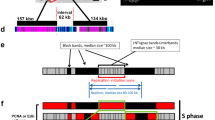Abstract
The replication patterns of larval salivary gland chromosomes of D. hydei and D. melanogaster were studied by autoradiography with tritiated thymidine injected in mid third instar larvae. The male X chromosome showed a different replication behavior in comparison to that of the female X chromosome and autosomes. It is concluded that the male X chromosome finishes its replication earlier than the female X chromosome. Moreover, the time needed for a complete replication cycle of individual identical replication units was found to be shorter in the male than in the female X chromosome. Although the whole X chromosomes behave different there were no differences observed in the sequence of the discontinuous labeling patterns of the two types of X chromosome. One autosomal replication unit was observed which showed a different replication behavior in males and females. The possible origin of the differential behavior of the two X chromosomes is discussed in terms of their difference in degree of polyteny.
Similar content being viewed by others
Literature
Aronson, J. F., G. T. Rudkin, and J. Schultz: A comparison of giant X chromosomes in male and female Drosophila melanogaster by cytophotometry in the ultraviolet. J. Histochem. Cytochem. 2, 458–459 (1954).
Baer, D.: Asynchronous replication of DNA in a heterochromatic set of chromosomes in Pseudococcus obscurus. Genetics 52, 275–285 (1965).
Berendes, H. D.: The salivary gland chromosomes of Drosophila hydei Sturtevant. Chromosoma (Berl.) 14, 195–206 (1963a).
—: Asynapsis in the salivary gland chromosomes of Drosophila hydei. Genetica 33, 288–300 (1963b).
Evans, H. J.: Uptake of H3thymidine and patterns of DNA replication in nuclei and chromosomes of Vicia faba. Exp. Cell Res. 35, 381–393 (1964).
Gabrusewycz-Garcia, N.: Cytological and autoradiographic studies in Sciara coprophila salivary gland chromosomes. Chromosoma (Berl.) 15, 312–344 (1964).
Gay, H.: Chromosome structure and function. Yearbook Carnegie Inst. Wash. 62, 503–510 (1963).
Hsu, T. C., W. Schmid, and E. Stubblefield: DNA replication sequences in higher animals. In: The role of chromosomes in development (ed. M. Locke), p. 82–112. New York: Academic Press 1964.
Keyl, H.-G., and C. Pelling: Differentielle DNS-Replikation in den Speicheldrüsenchromosomen von Chironomus thummi. Chromosoma (Berl.) 14, 347–359 (1963).
Lima de Faria, A.: Differential uptake of tritiated thymidine into hetero- and euchromatin in Melanoplus and Secale. J. biophys. biochem. Cytol. 6, 457–466 (1959).
Morishima, A., M. M. Grumbach, and J. H. Taylor: Asynchronous duplication of human chromosomes and the origin of sex chromatin. Proc. nat. Acad. Sci. (Wash.) 48, 756–763 (1962).
Mukherjee, A. S., and W. Beermann: Synthesis of ribonucleic acid by the X chromosome of Drosophila melanogaster and the problem of dosage compensation. Nature (Lond.) 207, 785–786 (1965).
Muller, H. J.: Further studies on the nature and causes of gene mutations. Proc. 6th Int. Congr. Genet. 1, 312–255 (1932).
Nicklas, R. B., and R. A. Jaqua: X chromosome DNA replication: Developmental shift from synchrony to asynchrony. Science 147, 1041–1043 (1965).
Offermann, C. A.: Branched chromosomes as symmetrical duplications. J. Genet. 32, 103–116 (1936).
Pelling, C.: A replicative and synthetic chromosomal unit: The modern concept of the chromomere. Proc. roy. Soc. B 164, 279–289 (1966).
Plaut, W., and D. Nash: Localized DNA synthesis in polytene chromosomes and its implications. In: The role of chromosomes in development (ed. M. Locke), p. 113–135. New York: Academic Press 1964.
—, and F. Fanning: Ordered replication of DNA in polytene chromosomes of Drosophila melanogaster. J. molec. Biol. 16, 85–93 (1966).
Rodkiewicz, B., and M. J. Olszewska: Asynchronie intra-et interchromosomique de l'incorporation de la thymidine H3 dans les chromosomes d'Haemanthus katharinae Bak. Chromosoma (Berl.) 14, 568–571 (1963).
Rudkin, G. T.: The proteins of the polytene chromosomes. In: The nucleohistones (ed. J. Bonner and P. Ts'o). San Francisco: Holden Day Inc. 1964.
Schmid, W.: DNA replication patterns of human chromosomes. Cytogenetics 2, 86–110 (1963).
Stern, C.: Dosage compensation: Development of a concept and new facts. Canad. J. Genet. Cytol. 2, 105–118 (1960).
Taylor, J. H.: Asynchronous duplication of chromosomes in cultured cells of Chinese hamster. J. biophys. biochem. Cytol. 7, 455–463 (1960).
Author information
Authors and Affiliations
Rights and permissions
About this article
Cite this article
Berendes, H.D. Differential replication of male and female X-chromosomes in Drosophila. Chromosoma 20, 32–43 (1966). https://doi.org/10.1007/BF00331896
Received:
Issue Date:
DOI: https://doi.org/10.1007/BF00331896




